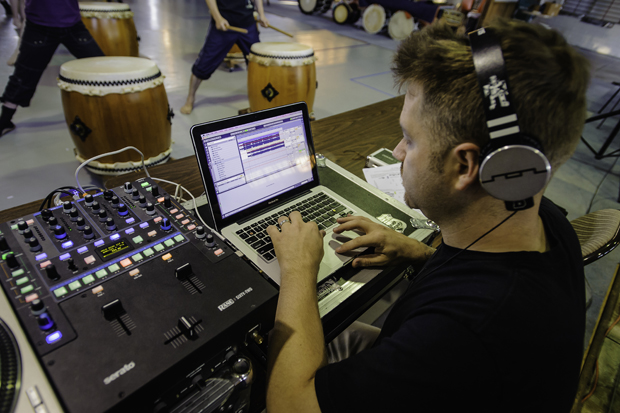“What I’m saying is we get ‘Super Freak’ in there and get the audience clapping,” says Dominic “Goldenchyld” Cueto as he cues up the familiar bass line at a rehearsal. It loops as members of San Jose Taiko nod their heads and rearrange themselves, heaving their big drums into the next configuration.
Cueto and Aaron “Squareweezy” Aquino of the Bangerz DJ collective sit behind laptops, turntables and tangles of wires in San Jose Taiko’s warehouse practice space, facing the drummers. Taiko’s artistic director, Franco Imperial, directs the performers and at times jumps in himself as the two groups iron out the wrinkles for their upcoming collaborative show at the Montgomery Theater on June 15.
Anyone who caught their first show together at the 2010 SubZERO festival knows what to expect. Even the YouTube video communicates the intense energy the two groups bring to the stage: the six members of the Bangerz rocking to the beat as they twist knobs and tap pads, San Jose Taiko in front of them thudding their drums in precise choreography. Everything stops. Then the beat drops, and the crowd goes nuts.
“In 2010, that was the big surprise because we didn’t know how audiences would react to it,” Imperial says. “I knew it was going to be awesome, but the audience reaction was just overwhelming. We were supposed to be kind of stoic [and] straight-faced, but then just this wave of energy came from the audience. It just touches something on a very primal level.”
Cueto follows up: “A DJ is solely playing music through speakers, and when you hear that you become very used to it. And now, when you add taiko and that live element, you’re listening in 3D almost. There’s an element of power that goes beyond what’s coming out of the speakers.”
The easy hook to reach for is the traditional Japanese drumming contrasted with the high-tech electronic production, the simplicity of the big drums and sticks juxtaposed with the bird’s nest of wires and electronics, but the story is more complicated than that and the contrast not as pronounced as it might first appear.
While taiko has been around in Japan in one form or another for thousands of years, the familiar ensemble style of taiko, called kumi daiko, actually originated relatively recently. In 1951, a Japanese jazz drummer named Daihachi Oguchi began to bring groups of drummers together to play, rather than the usual single drummer.
The new style was imported to the United States, and in 1968 the first organized group made its debut in San Francisco. By 1973, San Jose Taiko was founded in Japantown, making it the third-oldest American taiko group.
When San Jose Taiko first hinted at another collaboration with the Bangerz, Imperial says the idea received varied reactions. “The younger generation said we’re totally gonna be there,” he says, but some of the older audience members were skeptical and more attracted to the “classics” of San Jose Taiko.
Pigeonholing the group as staid, though, can be misleading. When the ensemble was founded by Roy Hirabayashi, he never intended to remain exclusively traditional without pushing the art forward, Imperial says.
“They were looking for a way to use taiko to express themselves as Asian Americans,” Imperial says. “That’s why the early music for us has influences of swing, jazz and R&B.”
Imperial says he still has older audience members who ask for “pure taiko,” but that is something that must be defined. “This is more San Jose Taiko than anything,” he says.
The Bangerz experience a similar struggle with categorization. With six DJs and producers all bringing different influences to the table, their songs easily become a eclectic mix of hip-hop and various electronic-music genres. But with this difficulty of categorization comes a certain freedom and the ability to try projects like the new one they are working on with San Jose Taiko.
Aquino likes to describe the two groups’ mix of styles as “chocolate and peanut butter” and, watching them perform, the comparison makes sense. Each group has a distinct sound and style—the swagger of the DJs, the controlled seriousness of the drummers—but they complement each other perfectly.
For one song in the new show, the taiko drummers start out with a row of bells, weaving quick rhythms between the high and low tones over cymbals and thumping drums. They fade it down, bring it back up, then the Bangerz drop a snare on the backbeat, and it all clicks naturally.
“[San Jose Taiko listens] to our tracks, and sometimes they hear things that we didn’t even realize were in them,” Cueto says. “They hear certain things in the music that we didn’t, but we understand how they could come up with that.”
Although the performance on June 15 is sold out, San Jose Taiko and the Bangerz say a tour of California could be in the works.
.San Jose Taiko and the Bangerz Join Forces for Weekend Show




